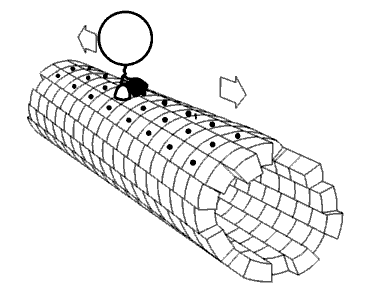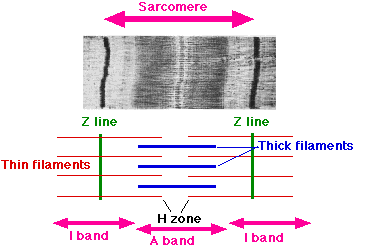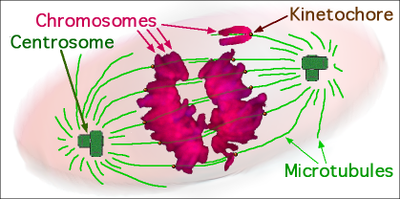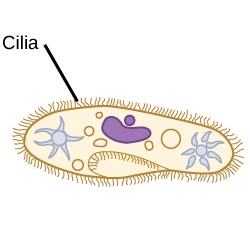Molecular Motors
Original Editor - Lucinda hampton
Top Contributors - Lucinda hampton and Vidya Acharya
Introduction[edit | edit source]
Did you know inside our bodies are little biological motors that carry cargo inside of our cells? These motors help to move important items inside of our cells. The motors move along tracks inside of our cells, the tracks start at the center of our cells and grow outward. The biological motors move along until they reach the place they need to go. They are vital to our cells dividing and help keep the cells in good working order by moving things inside of our cells. Remarkably, the fundamental biochemical mechanisms that produce contractions in our muscles are the same as those that propel organelles along defined paths inside cells.[1]
Image 1: Animation of kinesin protein "walking"
These fascinating molecular motors called are motor proteins. These proteins bind to a polarized cytoskeletal filament and use the energy derived from repeated cycles of ATP hydrolysis to move steadily along it. Dozens of different motor proteins coexist in every eucaryotic cell.
- They differ in the type of filament they bind to (either actin or microtubules), the direction in which they move along the filament, and the “cargo” they carry.
- Many motor proteins carry membrane-enclosed organelles, such as mitochondria, Golgi stacks, or secretory vesicles ( eg hormones or neurotransmitters), to their appropriate locations in the cell.
- Other motor proteins cause cytoskeletal filaments to slide against each other, generating the force that drives such phenomena as muscle contraction, ciliary beating, and cell division (mitosis).[2]
Basics[edit | edit source]
Motor proteins use the energy of ATP hydrolysis to move along microtubules or actin filaments. They mediate the sliding of filaments relative to one another and the transport of membrane-enclosed organelles along filament tracks.
- All known motor proteins that move on actin filaments are members of the myosin superfamily.
- The motor proteins that move on microtubules are members of either the kinesin superfamily or the dynein family.
The myosin and kinesin superfamilies are diverse, with about 40 genes encoding each type of protein in humans. The only structural element shared among all members of each superfamily is the motor “head” domain. These heads can be attached to a wide variety of “tails,” which attach to different types of cargo and enable the various family members to perform different functions in the cell. Although myosin and kinesin walk along different tracks and use different mechanisms to produce force and movement by ATP hydrolysis, they share a common structural core, suggesting that they are derived from a common ancestor[2].
Two types of specialized motility structures in eucaryotic cells consist of highly ordered arrays of motor proteins that move on stabilized filament tracks. The myosin-actin system of the sarcomere powers the contraction of various types of muscle, including skeletal, smooth, and cardiac muscle. The dynein-microtubule system of the axoneme powers the beating of cilia and the undulations of flagella.
Below are examples of Molecular Motors in our Bodies.
Muscle Contraction[edit | edit source]
Muscle contraction is the most familiar and the best understood form of movement in animals. Running, walking and swimming all depend on the rapid contraction of skeletal muscle on its scaffolding of bone, while involuntary movements such as heart pumping and gut peristalsis depend on the contraction of cardiac muscle and smooth muscle, respectively. These forms of muscle contraction depend on the ATP-driven sliding of highly organized arrays of actin filaments against arrays of myosin II filaments.ie on molecular motors
- Sarcomere shortening is caused by the myosin filaments sliding past the actin thin filaments, with no change in the length of either type of filament. Bipolar thick filaments walk toward the plus ends of two sets of thin filaments of opposite orientations, driven by dozens of independent myosin heads that are positioned to interact with each thin filament[2].
Mitosis[edit | edit source]
When our cells divide, in a process called mytosis, they need to have copy of everything that was in the original cell that divided.
- Molecular motor proteins of the kinesin and dynein superfamilies are essential players in the functional microanatomy of mitosis. They power various aspects of spindle assembly and function, including establishing spindle bipolarity, spindle pole organization, chromosome alignment and segregation, regulating microtubule dynamics, and cytokinesis[3].
- The microtubular tracks start at the center of the cell and move out in two opposite directions and cary the same cargo to each of the new cells. The motors will carry things such as DNA after replication to the new cells that are produced during the process of mytosis.
Cilia and Flagella[edit | edit source]
Cilia and flagella, which are antenna-like structures that protrude from most of the cells in our body, contain many microtubules. They have diverse roles in many tissues and organs in mammals, such as cell migration and generation of external fluid flow.
- Ciliary and flagellar movements are generated by MT sliding with axonemal dynein motors.[4]
- An example of flagell is the sperm tail, which is essential for male fertility and thus for sexual reproduction. One of the most specialized functions of microtubules is found in the sperm tail or flagellum. The flagellum has to beat in a very precise and coordinated manner to allow progressive swimming of the sperm. Failure to do so can lead to male infertility[5].
Axonal Transport[edit | edit source]
Both cytoskeletal filaments and motor proteins are required for axonal transport (members of the kinesin superfamily and cytoplasmic dynein are the key motors in the axonal traffic machinery).
- The motor proteins move a variety of cargos on microtubule tracks, including membrane organelles, protein complexes, complexes of nucleic acids, signaling molecules, and neuroprotective and repair molecules, and are required for the removal of misfolded or aggregated protein and vesicular and cytoskeleton components.[6].
Malfunction[edit | edit source]
Genetic and acquired defects in the molecular motors cause disease by preventing developing cells from migrating to their necessary destinations before birth or by preventing parts of the body, such as sperm tails or the tiny hairs that keep mucus flowing in the lungs, from moving when they are supposed to. The breakdown of this transportation system has also been associated with neurodegenerative diseases eg Alzheimer's and Huntington's disease
The molecular motors in parasitic organisms contribute to disease by enabling the parasites to break through biological barriers within the human body and actively invade cells.
References[edit | edit source]
- ↑ Penn state Uni.MOLECULAR MOTORS FAQS Available from:https://www.mrsec.psu.edu/content/molecular-motors-faqs (accessed 16.1.2021)
- ↑ 2.0 2.1 2.2 Alberts B, Johnson A, Lewis J, Raff M, Roberts K, Walter P. Molecular motors. InMolecular Biology of the Cell. 4th edition 2002. Garland Science.Available from: https://www.ncbi.nlm.nih.gov/books/NBK26888/(accessed 16.1.2021)
- ↑ Mountain V, Compton DA. Dissecting the role of molecular motors in the mitotic spindle. The Anatomical Record: An Official Publication of the American Association of Anatomists. 2000 Feb 15;261(1):14-24.Available from:https://onlinelibrary.wiley.com/doi/10.1002/%28SICI%291097-0185%2820000215%29261%3A1%3C14%3A%3AAID-AR5%3E3.0.CO%3B2-E (accessed 16.1.2021)
- ↑ Howard Lab Ciliary and flagellar motility Available from: https://howardlab.yale.edu/research/ciliary-and-flagellar-motility (accessed 16.1.2021)
- ↑ Phys org. Keeping sperm cells on track Available from: https://phys.org/news/2021-01-sperm-cells-track.html (accessed 16.1.2021)
- ↑ PERLSON E, HOLZBAUR EL. The Role of Molecular Motors in Axonal Transport. InProtein Trafficking in Neurons 2007 Jan 1 (pp. 29-43). Academic Press. (accessed 16.1.2021) Available from:https://www.sciencedirect.com/science/article/pii/B9780123694379500049 (accessed 16.1.2021)










